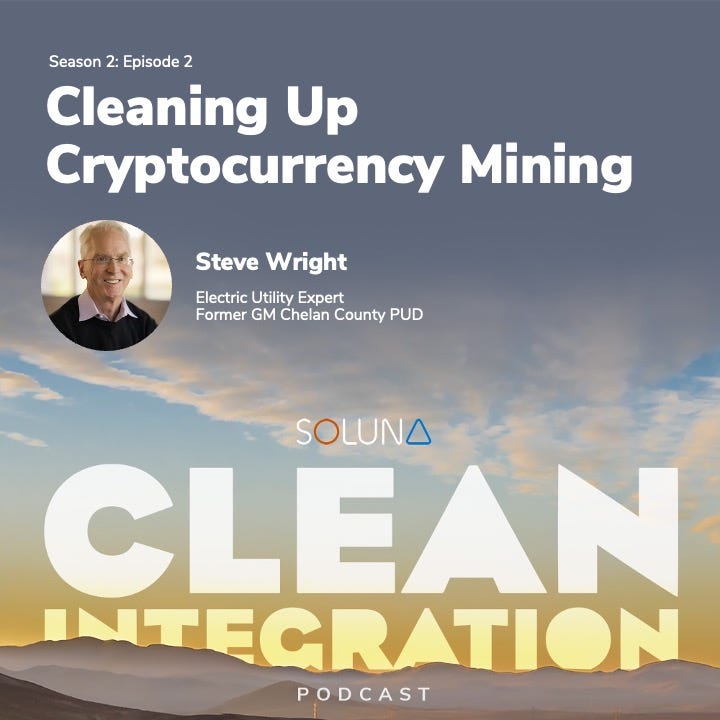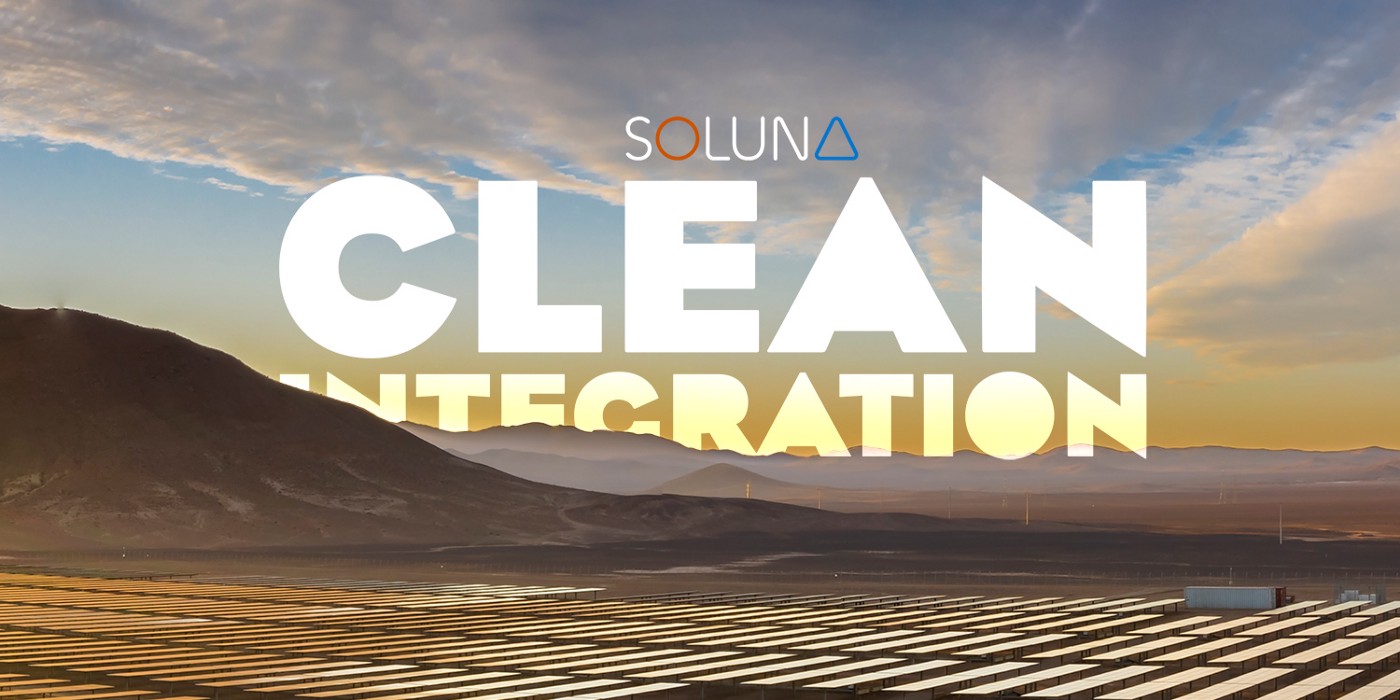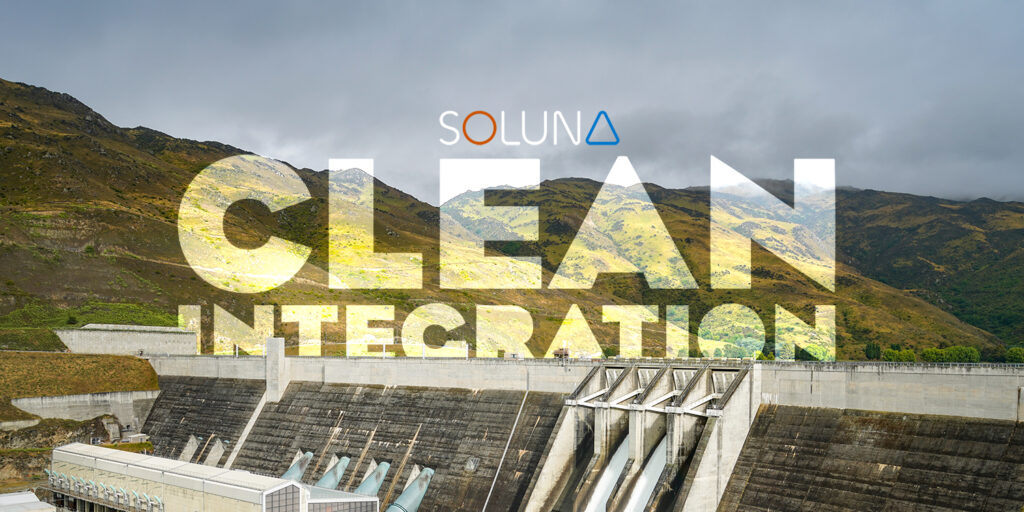Listen now on Apple | Spotify | SimpleCast
Recently, we’ve taken a deep dive into the ongoing debate over crypto mining regulation, and the types of incentives that would stabilize the grid and catalyze clean power growth on our podcast Clean Integration.
Perhaps the best way to understand the future of crypto mining and the electricity grid would be to put both parties–utility operators and crypto miners–in direct conversation.
We had the opportunity to examine a case study from 2014 when new Bitcoin miners quickly set up shop in Chelan County, Washington.
Steve Wright, the former CEO of the Chelan County Public Utility District (PUD) and of the Bonneville Power Administration, joins Soluna Computing CEO John Belizaire to talk about the good, the bad, and the learning potential of that experience.
With a 40-year career in energy, Steve has witnessed an influx of power customers interested in his state’s abundance of hydropower.
Providing his utility perspective on crypto mining and the grid, Steve walks us through the steps we can take to ensure a compatible future for clean energy and crypto.
Like John, Steve was invited to testify at the House Oversight Subcommittee hearing on January 20th called Cleaning up Crypto: The Energy Impacts of Blockchains. During that hearing, our members of Congress were seeking information about the sector’s energy use. Read Steve’s testimony here.
(This transcript has been edited and condensed for print.)
[10:22] How can we get the crypto industry and the electric utility industry to engage in direct conversation?
Steve Wright: Well, I’m glad you asked that because I’ve been thinking about it and I don’t have a very well-formulated thought. But I have basic thoughts, let’s say.
There have been some forums created in order to address emerging issues where you get people together who wouldn’t normally get together. I know the Alliance to Save Energy, for example, has put together forums on transportation and electrification to try and get the auto industry and the electric industry, and a variety of other players together.
I don’t think this is just one conversation. I think it’s probably something that would take a little bit of time. I actually have this dream that I’ve been thinking about since the hearing.
What I haven’t seen is something that would compare to a cryptocurrency miner the cost of reducing its output on the system against the rate benefit that it would get. Because if you’re reducing output, you’re reducing revenue, right? There’s only so much that you do. You get free power, but if you’re not producing anything…
Steve Wright: There’s a crossover point between, here is the rate and here’s the value to the power system. On the power system side, there were a variety of different things that were described at the hearing all the way from what we would call frequency response.
Although, I don’t think that those words were used at the hearing, which is a four-second reaction to things that are going on in the system to things that could go on for weeks or months.
Each of those time sequences has a different value to the power system. So, you could actually begin to analytically work through: here is the value of four seconds, five minutes, one hour, all the way up to months to the power system. The loss and value to a cryptocurrency miner are based on their time sequence and how frequently it was used.
It’s not an impossible analysis to do. It just would take a little bit of work and understanding communication between the two bodies to be able to figure that out. I think that would be really interesting to work through.
John Belizaire: I agree. I think that would be a fascinating piece of study to read and review because it would probably influence some approaches to bringing the two worlds together. When you and I talked before the testimony, I was sort of sharing our vision for the space and what we’re working on. And you said something during the call that stuck with me. You’re referring to our model being the holy grail. What did you mean by that?
I mean, I want to explore this concept of flexible load, seeing these types of data centers as a resource, essentially. And you put that in the context of the sheer magnitude of amounts of green power we want to put on the grid and so forth, and renewable energy goals that certain states have.
[14:13] What is the holy grail for how the cryptocurrency industry might be able to help the utility?
Steve Wright: I have to say I was so glad that we talked before the hearing because it helped to open my eyes to some of the things that you and others may be working on in the cryptocurrency industry, where I could begin to see the benefits of collaboration between our industries.
There are similarities between the way hydropower operates and the way solar and wind operate that I think will make this applicable to what is likely to be a large-scale expansion of solar and wind not only in the U.S. but in the international power system as well.
As hydropower owners, we have a certain amount of water that we count on. During the worst water year in history, we call that firm energy, and anything above that is variable streamflow. You don’t count on variable streamflow to be there for planning purposes. Remember from a utility standpoint, you are supposed to ensure that you have enough generation to meet your forecasted loads.
It’s mother nature controlling the output of your generation. Because of that, you are going to have a certain amount of energy you’re going to put on the grid as it becomes available and not sold as a firm resource. In the Northwest, we have spent a lot of time trying to figure out how to create maximum value out of that variable resource.
Generally, what has been done is that it is used to displace a generating resource that has a low fixed cost and high variable cost. You’re then reducing the variable cost which has a lot of value. Economically, it makes sense. Usually, that’s a natural gas-powered plant. We’ve had lots of exchanges, billions and billions of dollars worth of exchanges, like that over the last 40 years.
As wind and solar come into the market, that’s a lot of what they do too. They come in as “displacement resources,” i.e. they displace the marginal cost generation on the system, usually natural gas-powered. In the Northwest, we’ve sought a load that could do something similar, and we’ve had very little success.
This is my one worry about the conversation with the cryptocurrency industry, because like I say, we’ve been down this path with other industries and not had much success. What we did was we would say, “Hey, look in good water years, we’d like to sell you more. And in bad water years, we’d like to sell you less. And if we can do that, we could offer you a lower rate than what the standard rate would be.”
So you’re modulating your load to reflect the output of the system. We did find one industry that could do that; the aluminum industry actually offered contracts like that. They were very difficult to implement because you get to this point and the aluminum industry says, “I’ve got all this capital invested in this plant, I need to produce as much aluminum as I can. And now you’re telling me I can’t because it’s a low water year.”
That trade-off got very hard. This is that curve that I was talking about before–the value of production versus the value of curtailment– that needs to be developed. If the cryptocurrency industry could provide that, we really can modulate our load. Then the electric power industry is going to have more and more variable energy resources operating on the system. It’s going to be looking for ways to be able to use it.
That becomes particularly difficult because we appear to be heading towards shutting down the natural gas-powered plants. Our natural market is going away. So, we need to find another way to be able to use those variable energy resources. It either is on the generation side or on the demand side.
So it is the holy grail: how do you find ways to create value out of a generating resource that you can’t count on being there and yet you have to have firm resources to meet load?
John Belizaire: And your concern, I think you had mentioned to me during our conversation, was that the crypto mining firms have the same challenge as the aluminum smelting plants. They also have a significant amount of capital that they’ve invested and they need to return that capital and generate as much revenue as they can.

[19:18] So, does that create a constraint in their ability to serve as a flexible load or a marginal resource in the way you described?
Steve Wright: I’m sure that it does because as far as I can tell these are large capital investments. I mean, you do save the variable cost of the electricity but that’s about it as far as I can tell. If you took it to the extreme, the extreme would be well, I don’t want you to operate at all. Then you’re generating no revenue. There’s no way that would make sense for the business to operate.
We know there is a crossover point there. I can do some amount of modulation to get a lower rate. I can’t do 100% all the time where I won’t be able to make my debt service payments. So we’d have to figure that out. And again, I think smart people could do that.
Now, here’s the other thing, it’s not like you figure it out once and then you’re done, because the power value markets are constantly changing. We’ve seen a near doubling of wholesale power market values in the west in the last 18 months.
John Belizaire: Why is there a doubling taking place? Is it because there’s a lot of load coming on?
Steve Wright: It’s more a function of the generation coming offline than it is load growing in the last couple of years. The fact that the states in the west have been putting in place very aggressive clean energy standards is sending signals that coal plants are going to have to be shut down. It’s more of a reduction in supply than it is an increase in demand that’s driving things at the moment.
There’s a lot of concern in the utility industry right now in the west in particular as to whether we will have adequate generation to be able to serve load over the course of the next few years. So, you have those kinds of things going on. You have a greater premium being placed on carbon-free resources, which means you get a higher price for carbon-free resources than you used to be able to get. It’s driving prices up.
Electricity markets are not unlike other markets; they’re volatile. In fact, before we ran into cryptocurrency, we used to say electricity is the most volatile commodity in the country. You have to anticipate that the prices are going to be rapidly changing all the time. Very difficult to forecast. Might be a different story a couple of years from now.
Similarly, you’re dealing with very volatile prices in the cryptocurrency industry. So you can’t just do an analysis and say, “Here’s how it works.” It’ll have to take into account that these values are going to be changing on each side at a pretty rapid pace. And you’re going to want to modulate the relationship between the two industries based on how those commodity price values are changing.
Sometimes we’ll also have to be pretty flexible in order to be able to work.
John Belizaire: Right. In other words, it’s not an optimization equation that you’re running once and done. It’s almost continuous depending on what’s happening when both sides are changing very quickly, right? Very rapidly.
Steve Wright: Yep, exactly.
John Belizaire: That’s fantastic. Could we talk a little bit about regulation? In last week’s Clean Integration podcast episode, I had two guests on, Sanjeev Kumar, who’s an advisor with us, and Kathryn Carpenter. We discussed potential regulations that could strike the balance between encouraging innovation and ensuring responsible growth.
For example, extending the investment tax credit to include mining assets, because they’re large, pretty significant investments. That could be a way to sort of offset and make that equation balance.
Maybe the DOE provides some funding or loan guarantees that reduce the cost of capital, and carbon taxes on non-renewables as a way to discourage sourcing power from legacy fuels.
[23:33] What’s your perspective on regulation that could encourage the right incentives in the mining industry?
Steve Wright: Well, I have two thoughts about that. John, I appreciated your testimony and the way you described it as a battery. I would say that makes a lot of sense to me. That in fact, you could think about it like a battery.
Although, the way that battery operates is not just a function of the chemistry inside the battery. In this case, it’s an economic optimization going back to that valuation of the commodity price curve that I was describing earlier. So it’s a bit different in that regard.
But clearly, if you had a tax credit of some kind, then it reduces your cost of capital, which is going to be one of the drivers of how often you would be able to use the modulation characteristic if you’re a utility. So it makes the modulation of cryptocurrency more attractive because it has lowered the cost of capital.
Fundamentally, that makes sense. I want to come back to why there really should be some analytical work done to try to figure out this optimization model between the two industries. I think there’s a lot of potential there, more good conversation to be had between the two industries.
Take somebody from the crypto industry and somebody from the electric industry and put them in a room and give them a month and tell them to come out with something. I think you probably could make that happen.
John Belizaire: I like that idea a lot. I think that’s a fantastic idea.
Steve Wright: There’s another piece to this, though. I know that sometimes the crypto industry doesn’t like us to talk about this, but I have to tell you, I think it’s relevant.
I described at the hearing, that in our community there was a whole list of reasons for concern. We were offered the chance to be the cryptocurrency capital of the world and people were evaluating, is that what we want to be or not? Is that a good thing? And one of the reasons that people were concerned is that there have been these nefarious uses of cryptocurrency that seem to create a pathway to successfully committing crimes that bother people.
People were saying “Wait a second, is that something that we want to be a part of?” And I’m told at least that it’s a very small fraction of the number of cryptocurrency transactions that take place. That may well be true, but I will also tell you as an electric utility, we spend a huge amount of money trying to protect against cybersecurity risks.
That cybersecurity risk does seem to be increased as a result of the availability of Bitcoin and other cryptocurrencies that make it difficult to track. This would be my advice, you can take it or leave it. I think it would be good to try to figure out a way to address the cybersecurity risk because there are some fairly significant costs to the economy as a whole.
I can just speak from my piece of that. I see our industry having to deal with issues that will be important to resolve in order to create comfort. We see the potential value, and there’s lots of value there, but there are some downsides. How do we mitigate the downside risk?
John Belizaire: To some extent, Professor Ari Juels’ perspective on the technology, said these side effects and one of them is that it seems to generate bad behavior in the fairest behavior because of the nature of the technology. How do we create things to mitigate that type of behavior, especially if these are going to become resources? Having exposure to cyber risk is the last thing you want as part of your grid infrastructure.
Steve Wright: Yeah. I mean, it’s hard to describe for you just how much time in the electric utility industry we now spend on cybersecurity risk and the comparison against even like five, six years ago. We’ve got entire groups now, pretty much every utility in the country.
We’re not a large utility at all, yet we still have a very large cybersecurity group that has to constantly monitor because there just are a lot of bad actors out there seeking to infiltrate the system on a minute-by-minute basis. Even a small system like ours is getting pinged all the time. So it has become a significant issue for us.




